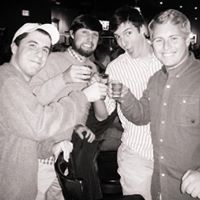Matthew S Bell
age ~58
from Santa Cruz, CA
- Also known as:
-
- Matthew Scott Bell
- Mathew Bell
- Matt Bell
- Marhew Bell
- Phone and address:
- 162 Tosca Ter, Santa Cruz, CA 95060
Matthew Bell Phones & Addresses
- 162 Tosca Ter, Santa Cruz, CA 95060
- 10797 Miguelita Rd, San Jose, CA 95127 • 408 937-9778
- 102 12Th St, San Jose, CA 95112
- Samoa, CA
- Sanger, CA
Us Patents
-
Interactive Video Display System
view source -
US Patent:7170492, Jan 30, 2007
-
Filed:Mar 18, 2005
-
Appl. No.:11/083851
-
Inventors:Matthew Bell - Palo Alto CA, US
-
Assignee:Reactrix Systems, Inc. - Redwood City CA
-
International Classification:G09G 5/00
G09G 5/08 -
US Classification:345158, 345156, 345157
-
Abstract:An interactive video display system. A display screen is for displaying a visual image for presentation to a user. A camera is for detecting an object in an interactive area located in front of the display screen, the camera operable to capture three-dimensional information about the object. A computer system is for directing the display screen to change the visual image in response to the object.
-
Interactive Video Display System
view source -
US Patent:7259747, Aug 21, 2007
-
Filed:May 28, 2002
-
Appl. No.:10/160217
-
Inventors:Matthew Bell - Palo Alto CA, US
-
Assignee:Reactrix Systems, Inc. - Redwood City CA
-
International Classification:G09G 5/00
G09G 5/08 -
US Classification:345156, 345157, 345158, 345159
-
Abstract:A device allows easy and unencumbered interaction between a person and a computer display system using the person's (or another object's) movement and position as input to the computer. In some configurations, the display can be projected around the user so that that the person's actions are displayed around them. The video camera and projector operate on different wavelengths so that they do not interfere with each other. Uses for such a device include, but are not limited to, interactive lighting effects for people at clubs or events, interactive advertising displays, etc. Computer-generated characters and virtual objects can be made to react to the movements of passers-by, generate interactive ambient lighting for social spaces such as restaurants, lobbies and parks, video game systems and create interactive information spaces and art installations. Patterned illumination and brightness and gradient processing can be used to improve the ability to detect an object against a background of video images.
-
Interactive Video Display System
view source -
US Patent:7348963, Mar 25, 2008
-
Filed:Aug 5, 2005
-
Appl. No.:11/197941
-
Inventors:Matthew Bell - Palo Alto CA, US
-
Assignee:Reactrix Systems, Inc. - Redwood City CA
-
International Classification:G09G 5/00
-
US Classification:345156, 345158
-
Abstract:An interactive video display system. A display screen is for displaying a visual image for presentation to a user. A camera is for detecting an object in an interactive area located in front of the display screen, the camera operable to capture three-dimensional information about the object. A computer system is for directing the display screen to change the visual image in response to the object.
-
Method And System For Combining Nodes Into A Mega-Node
view source -
US Patent:7428542, Sep 23, 2008
-
Filed:May 31, 2005
-
Appl. No.:11/142115
-
Inventors:Steve Fink - San Carlos CA, US
Malik Coates - San Francisco CA, US
Russell H. Belfer - Burlingame CA, US
Matthew T. Bell - Palo Alto CA, US -
Assignee:Reactrix Systems, Inc. - Redwood City CA
-
International Classification:G06F 17/00
G06F 7/00 -
US Classification:707100, 707 10, 707101, 707102, 7071041, 707200
-
Abstract:A method and system for combining nodes in a file used for loading a node graph. The method includes defining a first node in the file as a mega-node of the file. The XML file includes a plurality of nodes arranged in parent/child relationships. The method proceeds by identifying a base node type for basing the mega-node upon.
-
Method And System For Processing Captured Image Information In An Interactive Video Display System
view source -
US Patent:7536032, May 19, 2009
-
Filed:Oct 25, 2004
-
Appl. No.:10/974044
-
Inventors:Matthew Bell - Palo Alto CA, US
-
Assignee:Reactrix Systems, Inc. - Redwood Shores CA
-
International Classification:G06K 9/00
G06F 3/00
G06F 9/00
H04N 7/16 -
US Classification:382107, 382103, 715761, 725135
-
Abstract:A method and system for processing captured image information in an interactive video display system. In one embodiment, a special learning condition of a captured camera image is detected. The captured camera image is compared to a normal background model image and to a second background model image, wherein the second background model is learned at a faster rate than the normal background model. A vision image is generated based on the comparisons. In another embodiment, an object in the captured image information that does not move for a predetermined time period is detected. A burn-in image comprising the object is generated, wherein the burn-in image is operable to allow a vision system of the interactive video display system to classify the object as background.
-
Interactive Directed Light/Sound System
view source -
US Patent:7576727, Aug 18, 2009
-
Filed:Dec 15, 2003
-
Appl. No.:10/737730
-
Inventors:Matthew Bell - Palo Alto CA, US
-
International Classification:G06F 3/033
-
US Classification:345158, 345156, 345157, 348744
-
Abstract:An interactive directed beam system is provided. In one implementation, the system includes a projector, a computer and a camera. The camera is configured to view and capture information in an interactive area. The captured information may take various forms, such as, an image and/or audio data. The captured information is based on actions taken by an object, such as, a person within the interactive area. Such actions include, for example, natural movements of the person and interactions between the person and an image projected by the projector. The captured information from the camera is then sent to the computer for processing. The computer performs one or more processes to extract certain information, such as, the relative location of the person within the interactive area for use in controlling the projector. Based on the results generated by the processes, the computer directs the projector to adjust the projected image accordingly. The projected image can move anywhere within the confines of the interactive area.
-
Processing An Image Utilizing A Spatially Varying Pattern
view source -
US Patent:7710391, May 4, 2010
-
Filed:Sep 20, 2004
-
Appl. No.:10/946414
-
Inventors:Matthew Bell - Palo Alto CA, US
Philip Gleckman - Boulder CO, US
Joshua Zide - Santa Barbara CA, US
Helen Shaughnessy - Mountain View CA, US -
International Classification:G09G 5/00
-
US Classification:345156, 345158
-
Abstract:An interactive video window display system. A projector projects a visual image. A screen displays the visual image, wherein the projector projects the visual image onto a back side of the screen for presentation to a user on a front side of the screen, and wherein the screen is adjacent to a window. An illuminator illuminates an object on a front side of the window. A camera detects interaction of an illuminated object with the visual image, wherein the screen is at least partially transparent to light detectable by the camera, allowing the camera to detect the illuminated object through the screen. A computer system directs the projector to change the visual image in response to the interaction. The projector, the camera, the illuminator, and the computer system are located on the same side of the window.
-
Method And System For Processing Captured Image Information In An Interactive Video Display System
view source -
US Patent:7809167, Oct 5, 2010
-
Filed:May 19, 2009
-
Appl. No.:12/468819
-
Inventors:Matthew Bell - Palo Alto CA, US
-
International Classification:G06K 9/00
G06F 3/00
H04N 7/16 -
US Classification:382107, 382103, 715761, 725135
-
Abstract:A method and system for processing captured image information in an interactive video display system. In one embodiment, a special learning condition of a captured camera image is detected. The captured camera image is compared to a normal background model image and to a second background model image, wherein the second background model is learned at a faster rate than the normal background model. A vision image is generated based on the comparisons. In another embodiment, an object in the captured image information that does not move for a predetermined time period is detected. A burn-in image comprising the object is generated, wherein the burn-in image is operable to allow a vision system of the interactive video display system to classify the object as background.
Lawyers & Attorneys

Matthew Allen Bell - Lawyer
view sourceLicenses:
Texas - Eligible To Practice In Texas 2010
Education:
University of Houston Law Center
Degree - Doctor of Jurisprudence/Juris Doctor (J.D.)
Graduated - 2010
University of Houston Law Center
Degree - Juris Doctor
Graduated - 2010
Degree - Doctor of Jurisprudence/Juris Doctor (J.D.)
Graduated - 2010
University of Houston Law Center
Degree - Juris Doctor
Graduated - 2010
Specialties:
Estate Planning - 25%
Commercial - 25%
Business - 25%
Mediation - 25%
Commercial - 25%
Business - 25%
Mediation - 25%
Medicine Doctors

Matthew L. Bell
view sourceSpecialties:
Diagnostic Radiology
Work:
Radiology Ltd
677 N Wilmot Rd, Tucson, AZ 85711
520 795-0520 (phone), 520 545-1705 (fax)
Radiology Ltd
330 N Wilmot Rd, Tucson, AZ 85711
520 742-4100 (phone), 520 326-7989 (fax)
Radiology Ltd
5301 E Grant Rd, Tucson, AZ 85712
520 795-2889 (phone), 520 795-6321 (fax)
Radiology Ltd
5960 N Ln Cholla Blvd, Tucson, AZ 85741
520 795-2889 (phone), 520 795-6321 (fax)
677 N Wilmot Rd, Tucson, AZ 85711
520 795-0520 (phone), 520 545-1705 (fax)
Radiology Ltd
330 N Wilmot Rd, Tucson, AZ 85711
520 742-4100 (phone), 520 326-7989 (fax)
Radiology Ltd
5301 E Grant Rd, Tucson, AZ 85712
520 795-2889 (phone), 520 795-6321 (fax)
Radiology Ltd
5960 N Ln Cholla Blvd, Tucson, AZ 85741
520 795-2889 (phone), 520 795-6321 (fax)
Education:
Medical School
Medical College of Wisconsin School of Medicine
Graduated: 2001
Medical College of Wisconsin School of Medicine
Graduated: 2001
Languages:
English
Spanish
Spanish
Description:
Dr. Bell graduated from the Medical College of Wisconsin School of Medicine in 2001. He works in Tucson, AZ and 3 other locations and specializes in Diagnostic Radiology. Dr. Bell is affiliated with Carondelet Saint Josephs Hospital and Tucson Medical Center.

Matthew Lee Bell
view sourceSpecialties:
Nuclear Medicine
Diagnostic Radiology
Diagnostic Radiology
Education:
Medical College of Wisconsin (2001)
Wikipedia References

Matthew Bell (Cricketer)

Matthew Bell (Footballer)

Matthew Bell (Indiana Politician)

Matthew Bell (Rugby League)
Isbn (Books And Publications)
-
Goethe'S Naturalistic Anthropology: Man And Other Plants
view source -
Author:Matthew Bell
-
ISBN #:0198158947
-
German Tradition Of Psychology In Literature And Thought, 1700-1840
view source -
Author:Matthew Bell
-
ISBN #:0521846269
-
Goethe
view source -
Author:Matthew Bell
-
ISBN #:0460882120
-
Goethe In English: A Bibliography Of The Translations In The Twentieth Century
view source -
Author:Matthew Bell
-
ISBN #:1904350321
License Records
Matthew William Bell
License #:
70108463 - Active
Category:
EMS Licensing
Issued Date:
Aug 1, 2016
Expiration Date:
Jun 30, 2018
Type:
First Responder (EMR)
Matthew Bell
License #:
2014028 - Expired
Issued Date:
Feb 23, 2014
Expiration Date:
Feb 23, 2015
Type:
Temporary Permit
Matthew M Bell
License #:
10180 - Active
Issued Date:
Aug 5, 2003
Expiration Date:
May 31, 2017
Organization:
Firm Not Published
Matthew Beard Bell Dvm
License #:
3485 - Active
Category:
Veterinary Medicine
Issued Date:
Apr 8, 2011
Effective Date:
Apr 8, 2011
Expiration Date:
Apr 1, 2018
Type:
Veterinarian
Name / Title
Company / Classification
Phones & Addresses
Chief Executive Officer
Matterport
Computer Software · Whol Computers/Peripherals
Computer Software · Whol Computers/Peripherals
140 S Whisman Rd SUITE A, Mountain View, CA 94041
840 Williams Way, Mountain View, CA 94040
444 Castro St, Mountain View, CA 94041
840 Williams Way, Mountain View, CA 94040
444 Castro St, Mountain View, CA 94041
FIRST LIGHT CLEVELAND, LLC
MRBELL OF BUCYRUS, LLC
B R D FARMS, LLC
DJB BELL INVESTORS, LLC
GUILD PROPERTIES LLC
ELITE CAPITAL SOLUTIONS, LTD
Resumes

Matthew Bell Clovis, CA
view sourceWork:
All-Bright Electric Company
Sacramento, CA
Aug 2014 to Feb 2015
Electrical apprentice Valley chrome plating Inc.
Clovis, CA
May 2014 to Aug 2014
Plating manufacture Wienerschnitzel
Clovis, CA
Mar 2013 to Sep 2013
Team Member/Team Leader Fosters Freeze
Clovis, CA
Aug 2012 to Feb 2013
Team Member/Team Leader
Sacramento, CA
Aug 2014 to Feb 2015
Electrical apprentice Valley chrome plating Inc.
Clovis, CA
May 2014 to Aug 2014
Plating manufacture Wienerschnitzel
Clovis, CA
Mar 2013 to Sep 2013
Team Member/Team Leader Fosters Freeze
Clovis, CA
Aug 2012 to Feb 2013
Team Member/Team Leader
Education:
Clovis Online
Clovis, CA
2010 to 2014
G.E.D in High School
Clovis, CA
2010 to 2014
G.E.D in High School

Matthew Jennifer Bell
view source
Matthew Charles Bell
view source
Matthew Michael Bell
view source
Matthew Douglas Bell
view source
Matthew Charles Bell
view source
Matthew Matchdogg Bell
view source
Matthew Belloney Bell
view source
Matthew Wallace Bell
view sourceYoutube
Myspace
Classmates

Matthew Bell
view sourceSchools:
Nome-Beltz High School Nome AK 1987-1991
Community:
Larry Schmidt, Dan Angusuc

Matthew Bell
view sourceSchools:
Choctaw Central High School Philadelphia MS 1993-1997
Community:
Dorian Osceola

Matthew Bell
view sourceSchools:
Mississippi School for Math & Science Columbus MS 2001-2003
Community:
James Baldwin

Matthew Bell
view sourceSchools:
Christchurch School Christchurch VA 1989-1993
Community:
Louis Randall, Andrew Murphy, Kevin Allen, Caswell Cooke, Ricky Rodriguez

Matthew Bell
view sourceSchools:
Christchurch School Christchurch VA 1989-1998
Community:
Louis Randall, Andrew Murphy, Kevin Allen, Caswell Cooke, Ricky Rodriguez

Matthew Bell
view sourceSchools:
Pilgrim Academy Egg Harbor NJ 1996-2000
Community:
Stephanie Surgent, Marjorie Johnson
Plaxo

Matthew Bell
view sourceCelebration & Lake, Florida, Wales

Matthew Bell
view sourceManaging Director at Bell IT 2000 Limited

matthew bell
view sourceInternational Financial Services

Matthew Bell
view sourceDivision Finance Controller at Forbo Flooring

Matthew Bell
view sourceResearch Postgraduate at University of Durham

Matthew Bell
view sourceMt. Pleasant, SC, USA
Flickr
Googleplus

Matthew Bell
Education:
University of St. Andrews - Philosophy, Penglais School, Aberystwyth
Tagline:
Happens to believe in contingency.

Matthew Bell
Work:
Self - Carpenter
Education:
Howard High School

Matthew Bell
Work:
B&M - Sales
Education:
Cramlington Learning Village - Music
Tagline:
Freaky idiot, uninteresting, yet incredibly loveable. Hopefully.

Matthew Bell
Work:
Teacher - School
Education:
St.Margrets

Matthew Bell
Education:
Coventry University - Aerospace Systems Engineering BEng (Hons)

Matthew Bell
Education:
TAFE - Diploma of Laboratory Pathology
About:
I was completely disappointed when I decided to take up study in a laboratory only to learn that mixing acids and bases didn't blow the lab apart. The Simpson's lied to me!

Matthew Bell
Work:
Holroyd - Machine Tool Fitter
Relationship:
Married

Matthew Bell
Work:
Bank of America - Mortgage Officer
Tagline:
Just waiting...
Get Report for Matthew S Bell from Santa Cruz, CA, age ~58













